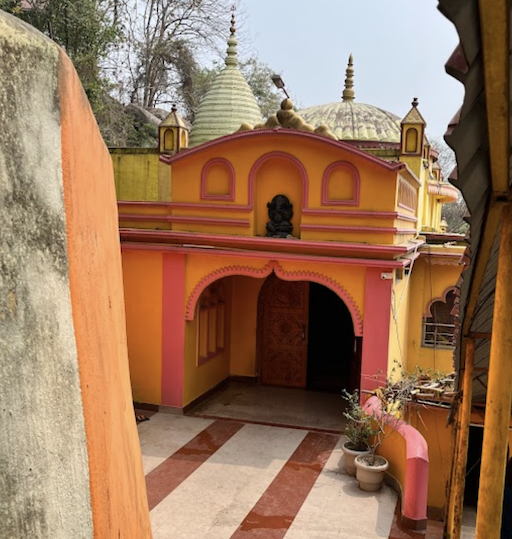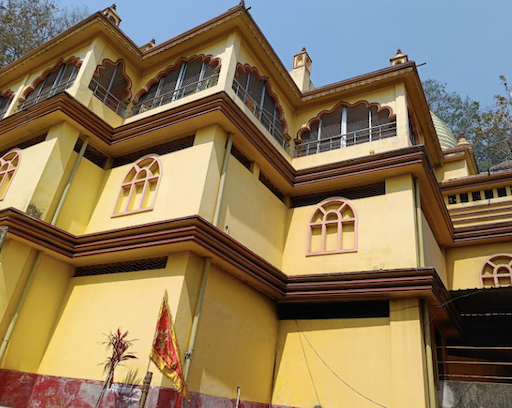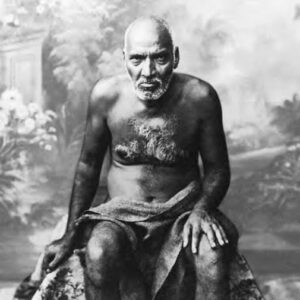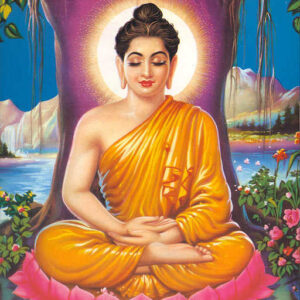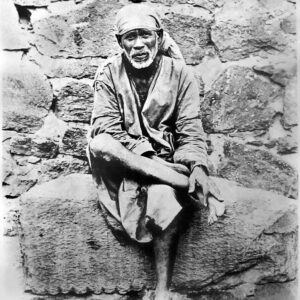Maa Bagalamukhi Temple is a one of ten Das Mahavidhya temple around Kamakhya temple.
There is a place to sit and meditate. You can go into meditative states here effortlessly.
How to Get there
The temple is located 500m East of Kamakhya Temple.
Map:
https://maps.app.goo.gl/MA5gtfFc43q6ZrXNA
About Maa Baglamukhi
Baglamukhi or Bagalā (Sanskrit: बगलामुखी) is the female form of a personification of the mahavidyas (great wisdom/science), a group of ten Tantrik deities in Hinduism. Devi Bagalamukhi smashes the devotee’s misconceptions and delusions (or the devotee’s enemies) with her cudgel. The word “Bagala” is derived from the word “Valga” (meaning – bridle or to rein in) which, became “Vagla” and then “Bagla”.[1] The Devi has 108 different names (some others also call her by 1108[2] names). Bagalamukhi is commonly known as Pitambari in North India, the goddess associated with yellow color or golden color. She sits on golden throne having pillars decorated with various jewels and has three eyes, that symbolises that she can impart ultimate knowledge to the devotee.
Bagalamukhi is one of the ten forms of the Devi, symbolising potent female, primeval force.
The main temples dedicated to Bagalamukhi or Bagala Devi are located at Bhagalamukhi dhevi Temple Shivampet, Telangana,Bagalamukhi Temple, Datia Madhya Pradesh, Bugiladhar, Ghuttu Uttarakhand, Kamakhya Temple, Guwahati, Assam, Baglamukhi temple of Lalitpur, Nepal and of Banghandi, Kangra, Himachal Bagalamukhi shaktipeetham Shivampeta, Narsapur, Telangana state.
Iconography
Another interpretation translates her name as “Kalyani”. In Kubjika Tantra there is a reference to yet another interpretation of the meaning of the name ‘Bagala’. In the initial chapter of the text, there is a verse – ‘Bakare Baruni Devi Gakare Siddhida Smrita. Lakare Prithivi Chaiba Chaitanya Prakrirtita’ (‘Ba’, the first letter of the name – ‘Bagala’, means ‘Baruni’ or ‘She Who is filled with the intoxicating mood to vanquish the demon’. ‘Ga’, the second letter, means ‘She Who grants all kinds of divine powers or siddhis and successes to human beings’. ‘La’, the third letter, means ‘She Who is the foundation of all kinds of sustaining powers in the world like the earth and is Consciousness Herself’.[3]
Two descriptions of the goddess are found in various texts: the Dwi-Bhuja (two-handed), and the Chaturbhuja (four-handed). The Dwi-Bhuja depiction is the more common and is described as the “Soumya” or milder form. She holds a club in her right hand with which she beats a demon, while pulling his tongue out with her left hand. This image is sometimes interpreted as an exhibition of stambhana, the power to stun or paralyse an enemy into silence. This is one of the boons for which Bagalamukhi’s devotees worship her. Other Mahavidya goddesses are also said to represent similar powers useful for defeating enemies, to be invoked by their worshippers through various rituals.
Bagalamukhi is also called Pitambaradevi, Shatrubuddhivinashini and Brahmastra Roopini and she turns each thing into its opposite.
The Tantrasara describes her iconography: Bagalamukhi sits in a golden throne in the midst of an ocean in an altar. Her complexion is yellow (golden). Clad in yellow clothes, she is adorned by a garland of yellow flowers and decked with yellow (golden) ornaments. She pulls the tongue of a demon by her left hand, while raising the right hand to strike him with a club.[4] Another description says that she has four arms and a third eye. A yellow crescent moon adorns her forehead.[4]
Though generally depicted with a human head, the goddess is sometimes described to have a head of a crane and sometimes depicted ridding a crane. Sometimes, she is described associated with other birds: having a duck-head or a nose of a parrot.[5]
Read More
